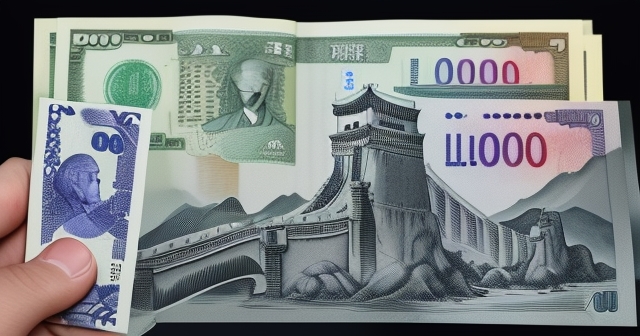
What is a Yuan: Understanding the Chinese Yuan and Its Global Impact
Table of Contents
ToggleUnderstanding the Chinese Yuan: More Than Just Money
Welcome to our exploration of the Chinese Yuan, officially known as the Renminbi (RMB). For anyone venturing into the world of global finance, particularly those interested in understanding the mechanics behind major currencies or those looking to deepen their grasp of technical analysis by factoring in macro fundamentals, grasping the intricacies of the Yuan is essential. It’s not just China’s domestic currency; it’s a powerful instrument deeply intertwined with the country’s economic policy, global trade, and geopolitical ambitions.
Often, when we think about currencies like the US Dollar or the Euro, we picture freely floating exchange rates determined purely by supply and demand in open markets. The Yuan, however, operates under a different, more controlled system. Understanding this control mechanism is the first step to truly decoding its behaviour and significance on the world stage.

| Currency Symbol | Description | Market Type |
|---|---|---|
| CNY | Onshore Chinese Yuan | Controlled by the People’s Bank of China |
| CNH | Offshore Chinese Yuan | Less regulated and more influenced by international market forces |
The Two Sides of the Coin: Onshore vs. Offshore Yuan (CNY and CNH)
One of the most crucial distinctions you need to understand is the difference between the onshore Yuan, typically referenced as CNY, and the offshore Yuan, known as CNH. While they represent the same currency, their markets and the rules governing them are quite distinct.
- CNY (Chinese Yuan): This is the Yuan traded and used within mainland China. It is subject to tight controls by the People’s Bank of China (PBoC), China’s central bank. Access to this market for international investors is managed and restricted, particularly concerning the capital account.
- CNH (Chinese Yuan Hong Kong): This is the Yuan traded outside of mainland China, primarily in offshore financial centres like Hong Kong. The CNH market is less regulated by the PBoC’s daily fix and is more influenced by international supply and demand dynamics, though significant discrepancies between CNY and CNH are often arbitraged or indicate policy signals.
Think of it like this: CNY is the local currency behind a guarded gate, while CNH is available in designated areas just outside the gate, making it more accessible to international travellers and businesses, but still influenced by what happens inside.

How the PBoC Manages the Onshore Yuan (CNY)
The People’s Bank of China doesn’t allow the CNY exchange rate to float freely. Instead, it manages the rate through a mechanism involving a daily “midpoint fix” and a trading band.
Every morning, before the start of onshore trading, the PBoC sets a daily central parity rate, or midpoint fix, for the Yuan against the US Dollar (USDCNY). This fix is based on various factors, including the previous day’s closing price, the rates quoted by market makers, and the PBoC’s policy objectives.
Once the fix is announced, the onshore spot rate (USDCNY) is permitted to trade within a specified percentage band around this fix. Currently, this band is 2% above or below the midpoint. This means the Yuan cannot strengthen or weaken by more than 2% against the US Dollar from the PBoC’s set rate on any given day in the onshore market.

This system gives the PBoC significant control over the pace and direction of the Yuan’s movement. The daily fix acts as a powerful signal of the central bank’s intentions. For example, setting a weaker fix signals a tolerance for depreciation, while a stronger fix suggests a preference for stability or appreciation. This contrasts sharply with major currencies like the USD or EUR, where central banks typically influence the exchange rate indirectly through interest rates and monetary policy, rather than setting a daily target range.
The Capital Account: The Key to Beijing’s Control
Understanding why China maintains this managed float system requires looking at the capital account. The capital account tracks the flow of funds for investments, loans, and other financial assets in and out of a country.
While the Yuan is largely convertible under the current account (which covers trade in goods and services – you can convert Yuan earned from exporting goods), the capital account remains closely managed and restricted by Beijing. Why the tight grip?
Beijing’s primary concern is preventing abrupt and potentially destabilizing capital flows. They worry that if investors and citizens were completely free to move money in and out of the country, large outflows could occur during times of economic uncertainty or perceived risk, potentially leading to a sharp currency depreciation, depletion of foreign exchange reserves, and broader financial instability. Conversely, unrestricted inflows could lead to asset bubbles and inflation.

This control allows the PBoC to manage the speed at which China integrates into the global financial system, ensuring stability is prioritized over full convertibility for the time being. It’s a balancing act between opening up for internationalization and maintaining domestic financial control.
Hong Kong’s Pivotal Role as the Offshore Yuan Hub
Given the restrictions on the onshore CNY market, Hong Kong has emerged as the dominant offshore Yuan hub (CNH market). Its proximity to mainland China, status as a major international financial center, and legal framework make it an ideal location for trading and settling Yuan transactions outside the direct control of the PBoC’s daily fix and band.
The CNH market serves several crucial functions:
- It provides international investors and businesses with access to the Yuan for trade settlement, investment, and hedging without needing full access to the mainland market.
- It acts as a testing ground for Yuan internationalization, allowing the PBoC to observe how the currency trades in a more market-driven environment.
- The price of CNH often reflects international sentiment towards the Yuan and the Chinese economy, sometimes trading at a premium or discount to CNY. Discrepancies can signal market stress or arbitrage opportunities.

Hong Kong has actively strengthened its position, with initiatives like increasing the availability of onshore Chinese bonds for use as repo collateral in Hong Kong and developing facilities to support Yuan-settled global trade. These steps aim to build out the infrastructure needed for wider international use of the currency.
Driving Yuan Internationalization: Initiatives and Progress
Despite the capital account controls, China has a stated ambition to internationalize the Yuan – to have it used more widely in global trade, investment, and as a reserve currency. This is a gradual process, supported by various initiatives.
One key area is promoting Yuan-denominated trade finance. As trade settlement in Yuan becomes more common, businesses outside China need access to CNH liquidity and financing options. Hong Kong’s efforts in this area, including providing financing facilities, are vital.
Increasing access for foreign investors to the mainland bond market is another important step. Allowing investors to hold and trade onshore bonds through offshore channels, such as repos or derivatives, helps build demand for Yuan-denominated assets and integrates China’s financial markets with the rest of the world, albeit on Beijing’s terms.

The development of the digital Yuan (CBDC – Central Bank Digital Currency) is also seen as potentially facilitating international use, making cross-border Yuan transactions more efficient and trackable. While primarily focused on domestic use initially, a digital Yuan could eventually ease settlement in areas like commodity trading, such as oil.
Why is internationalization a goal? A more widely used Yuan could reduce China’s reliance on the US Dollar system, lower transaction costs for Chinese businesses trading globally, and enhance China’s financial influence on the global stage.
The Yuan in the Trade War Era: Weapon or Risk?
One of the most significant points of discussion surrounding the Yuan, particularly in recent years, has been its role (or potential role) in the context of trade tensions, especially with the United States. Could China strategically weaken the Yuan to offset the impact of US tariffs on its exports?
On the surface, a weaker Yuan makes Chinese goods cheaper for foreign buyers (including those in the US), potentially mitigating some of the price increase caused by tariffs. This led to speculation and accusations that China was a “currency manipulator.”
However, the provided data analysis and expert views suggest that while Beijing *could* allow the Yuan to depreciate, significant or rapid weakening carries substantial risks that likely outweigh the benefits as a trade war tool:
- Capital Flight: A sharp depreciation could panic domestic investors and businesses, leading them to try and move their money out of China, potentially causing massive capital outflows.
- Financial Instability: Large capital outflows and rapid currency drops can destabilize the domestic financial system, impacting banks, companies with foreign debt, and asset markets.
- Loss of Confidence: Aggressive devaluation could damage confidence in the Yuan and China’s economy internationally, hindering the long-term goal of internationalization.
- Retaliation: It could trigger further retaliation from trading partners, escalating the trade conflict into a currency war.
For these reasons, analysts often conclude that Beijing’s primary focus remains Yuan stability. While the PBoC may allow gradual depreciation via the midpoint fix to adjust to market conditions or economic pressure, a deliberate, sharp devaluation as a primary weapon is considered unlikely due to the severe domestic financial risks.
Instead, the PBoC seems to prefer introducing more two-way volatility within the trading band and potentially relying more on domestic stimulus measures to support the economy against trade headwinds, rather than risking stability with currency depreciation.
Economic Data’s Influence on Yuan Volatility
Like any currency, the Yuan’s value is ultimately linked to the health and performance of its underlying economy. While the PBoC manages the rate, economic indicators still play a significant role, particularly influencing the more market-driven CNH and shaping the PBoC’s policy decisions (which then impact CNY).
Weak economic data points, such as slowing retail sales, industrial production, or fixed asset investment, can increase pressure for the Yuan to depreciate as investors anticipate potential monetary easing or economic slowdown. Conversely, strong data can support the currency.
News related to trade tensions, geopolitical developments, or shifts in global risk sentiment also directly impact Yuan volatility. The CNH, being more sensitive to international market forces, often reacts more sharply to such news than the controlled CNY.
For traders, monitoring key Chinese economic releases and geopolitical developments is crucial for anticipating potential Yuan movements, even within the managed system. Understanding the *why* behind the PBoC’s daily fix often requires looking at the economic context and market sentiment of the preceding 24 hours.
Monetary Policy Signals: What PBoC Rate Decisions Tell Us
Although the PBoC uses the midpoint fix as its primary tool for managing the daily exchange rate, its monetary policy decisions, such as setting key interest rates like the Medium-term Lending Facility (MLF) rate, also send important signals that can impact the Yuan.
Keeping interest rates steady, as the PBoC has often done even when other central banks were easing or when the domestic economy showed signs of slowing, can indicate a deliberate choice to prioritize currency stability over aggressive monetary stimulus. Lowering rates could put downward pressure on the Yuan by making Yuan-denominated assets less attractive compared to those in countries with higher rates, potentially accelerating capital outflows.
Therefore, when you analyze the PBoC’s monetary policy announcements, don’t just look at the interest rate changes in isolation. Consider them in the context of the central bank’s broader goals, where currency stability often features prominently, especially during periods of heightened uncertainty or capital flow concerns.
Corporate Strategies: Hedging Against Yuan Risk
For businesses operating in or trading with China, managing currency risk related to the Yuan is a significant challenge, especially with the volatility introduced by trade tensions and economic shifts. Companies exposed to the Yuan need strategies to hedge against adverse movements.
This involves using financial instruments like foreign exchange derivatives – such as forwards, futures, or options – to lock in exchange rates for future transactions or protect the value of Yuan-denominated assets or liabilities. For example, a Chinese exporter selling goods in US Dollars might use a forward contract to sell those future USD receipts for Yuan at a predetermined rate, protecting them from a potential depreciation of the USD against the Yuan before they receive payment.
Conversely, a company importing goods into China and needing to pay in Yuan might hedge against a potential Yuan appreciation. The increased demand for such hedging services, noted by institutions like Standard Chartered, underscores the market’s awareness and concern regarding Yuan volatility.
This is where the practical side of foreign exchange trading comes into play for businesses and investors. Understanding how to analyze currency movements isn’t just academic; it has real-world implications for managing financial risk and planning international operations.
If you’re an investor looking to trade currency pairs, or perhaps explore leveraged products like Contracts for Difference (CFDs) based on currencies and other assets, having access to a reliable and versatile trading platform is crucial. Such platforms provide the tools needed to analyze markets, manage risk, and execute trades efficiently.
If you are considering starting your journey in forex trading or looking to explore a wide range of CFD instruments, then Moneta Markets is a platform worth considering. Originating from Australia, it offers access to over 1000 financial instruments, catering to both novice and experienced traders.
The Geopolitical Chessboard: De-dollarization and the Yuan’s Future
Beyond economic policy and trade, the Yuan’s trajectory is increasingly influenced by global geopolitical dynamics. Discussions around de-dollarization – the idea of countries reducing their reliance on the US Dollar for trade and reserves – present both opportunities and challenges for the Yuan’s internationalization ambitions.
As some countries seek alternatives to the dollar-dominated system, particularly in response to geopolitical tensions or sanctions, the Yuan could potentially gain traction as an alternative for trade settlement or holding reserves. China is actively promoting the use of Yuan in specific areas, such as the oil trade, which could pave the way for wider acceptance.
Policies enacted elsewhere, such as debates in the US about potential restrictions on digital currencies or access to the dollar system, could inadvertently accelerate the de-dollarization trend and push more countries towards exploring alternatives, including the Yuan.
While the US Dollar’s dominance is deeply entrenched, geopolitical shifts are creating a landscape where the Yuan is poised to play a larger, albeit gradually increasing, role on the global financial stage. This long-term trend is a key factor for anyone looking at the future of global currencies.
Navigating Yuan Trading: Risks and Opportunities
For traders and investors, the Yuan, whether CNY or CNH, presents a unique set of dynamics. Unlike fully free-floating currencies, its movements are heavily influenced by policy decisions from the PBoC and regulatory actions by Beijing. This means traditional technical analysis needs to be combined with a deep understanding of China’s economic and political landscape.
Trading CNH (offshore Yuan) is generally more accessible to international participants than CNY. The USD/CNH pair is actively traded in global forex markets. Volatility in this pair is often driven by news related to trade relations, China’s economic data releases, PBoC statements (or perceived signals from the CNY fix), and global risk sentiment.
Opportunities might arise from anticipating PBoC policy shifts, reacting to major economic data surprises, or navigating periods of heightened geopolitical tension. However, the risk of sudden policy intervention from Beijing, designed to curb excessive volatility or speculation, is always present. This is often referred to as “policy risk.”
Hedging against or speculating on Yuan movements requires access to platforms that offer the USD/CNH pair and provide reliable execution and relevant market data. Understanding the correlation between CNY and CNH, and how the PBoC attempts to manage this relationship, is also vital for effective trading.
When selecting a trading platform, factors like regulatory compliance, the range of available instruments, trading costs (spreads), and the reliability of the trading technology are paramount. Given the complexity of the Yuan market, having access to robust tools and support is beneficial.
If you are looking for a forex broker with regulatory backing and global trading capabilities, Moneta Markets holds multi-country regulatory certifications like FSCA, ASIC, and FSA. They also offer comprehensive support including segregated client funds, free VPS, and 24/7 Chinese customer service, making them a top choice for many traders.
Conclusion: The Yuan’s Deliberate Path Forward
In summary, the Chinese Yuan (Renminbi) is a currency on a deliberate path. Managed closely by the PBoC through mechanisms like the daily midpoint fix and capital controls, its primary objective remains domestic financial stability. The distinction between the controlled onshore CNY and the more market-influenced offshore CNH (primarily in Hong Kong) is fundamental to understanding its behaviour.
While the Yuan is often discussed in the context of trade wars and potential strategic devaluation, the risks of capital flight and financial instability appear to constrain Beijing from undertaking aggressive weakening. Instead, policy leans towards stability and gradual, controlled internationalization.
Economic data, monetary policy signals, and geopolitical shifts all influence the Yuan’s value and volatility, requiring anyone trading or investing in it to adopt a holistic approach that combines fundamental analysis of China’s economy and policy with technical trading strategies. As China continues its integration into the global economy, the Yuan’s role will undoubtedly grow, making its dynamics increasingly important for global financial markets.
what is a yuanFAQ
Q:What is the difference between CNY and CNH?
A:CNY is the onshore Yuan used in mainland China, while CNH is the offshore Yuan traded in markets outside China.
Q:How does the People’s Bank of China manage the Yuan?
A:The PBoC manages the Yuan using a daily midpoint fix and allows it to trade within a set percentage band against the US Dollar.
Q:Why is the internationalization of the Yuan important?
A:Internationalization can reduce China’s reliance on the US Dollar, lower costs in global trade, and enhance China’s global financial influence.
You may also like
Calendar
| 一 | 二 | 三 | 四 | 五 | 六 | 日 |
|---|---|---|---|---|---|---|
| 1 | 2 | 3 | 4 | 5 | 6 | 7 |
| 8 | 9 | 10 | 11 | 12 | 13 | 14 |
| 15 | 16 | 17 | 18 | 19 | 20 | 21 |
| 22 | 23 | 24 | 25 | 26 | 27 | 28 |
| 29 | 30 | 31 | ||||
發佈留言
很抱歉,必須登入網站才能發佈留言。